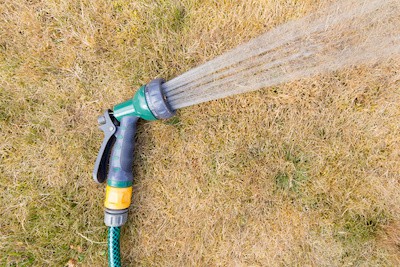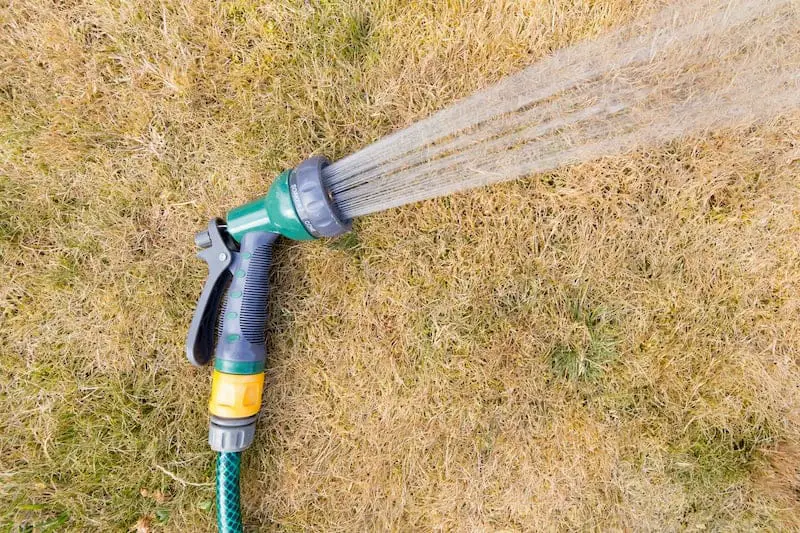Help Your Lawn Recover From a Drought
Droughts can wreak havoc on your lawn and cause the grass to weaken and die. Just live every living thing, grass needs water to survive. If you live in a climate where months without rain is normal, then you may be used to dealing with a withered lawn. On the other hand, if you live in an area that has randomly experienced a drought, you may be surprised to see your yard look so lifeless.
So, how can you help your lawn recover from a drought? Here are some tips you can use to help the grass in your lawn survive a drought:
- Water Your Lawn Regularly
- Fertilize Your Lawn Throughout the Year
- Re-Seed in Patchy Areas
- Raise the Mower Blade
- Aerate Your Lawn So Grass Roots Can Receive Moisture
- Leave Grass Clippings on the Lawn
Not only will some of these points improve your lawn during the drought, but they will also help the lawn to recover afterward and return to normal. Droughts can cause the grass to die, making your lawn look like a barren desert. By taking action early, you can preserve the grass, even if it turns brown. Keep reading to get an in-depth look at each point.
Water Your Lawn Regularly During a Drought
 Watering your lawn regularly seems like the most obvious way to get your lawn through drought season; however, if you’re in an area that regularly experiences drought, then this may not be an option. Regions that are prone to droughts tend to put restrictions on watering your lawn. This allows for the city or the county to preserve its public water supply for the citizens.
Watering your lawn regularly seems like the most obvious way to get your lawn through drought season; however, if you’re in an area that regularly experiences drought, then this may not be an option. Regions that are prone to droughts tend to put restrictions on watering your lawn. This allows for the city or the county to preserve its public water supply for the citizens.
If this is the case for the area you live in, regularly watering your lawn may not be an option. On the other hand, if you live in an area that doesn’t usually experience drought, then there may not be any restrictions on watering your lawn. If this is the case, watering your lawn deeply every 2-3 days can greatly preserve the life of your grass. Your lawn needs 1″-1.5″ of water a week to stay healthy.
Although you’ll want to ensure that your lawn is getting a deep watering, you don’t want to flood your lawn all at once. Flooding your lawn could result in water damage to your home, something that would require a professional cleaning business.
The best practice for watering your lawn is using a sprinkler system that can gradually soak the lawn with water. Sprinklers come in handy because they can also water a large area compared to trying to water the lawn with just a hose.
Fertilize Your Lawn Throughout the Year to Enhance the Soil During a Drought
During a drought, the soil in your lawn will become dry and weak. The grass won’t be able to get the proper nutrients needed to survive. One way you can help both prepare and recover your lawn from drought is by fertilizing your lawn throughout the year.
Lawn fertilizer adds certain nutrients to the soil that can grass needs to flourish. Soil that lacks nutrients will grow weak grass or no grass at all. Some fertilizers can also work to kill weeds. Weeds prosper is dry and arid soil, so choosing fertilizer that will kill weeds can help protect your lawn from lawn parasites during a drought.
Contrary to popular beliefs, you should be fertilizing your lawn year-round. By doing this, you’re helping your lawn prepare for the next season to come. Each season is a new challenge for your lawn, and with the right nutrients, your lawn is more likely to survive.
The best time to fertilize your lawn is in the early spring as the grass just starts to grow. This will ensure that the grass has all the nutrients it needs to grow healthy. Depending on the fertilizer you use, the bag of fertilizer may instruct you to apply the nutrients every 4-8 weeks. It’s important to refer to the recommended schedule so that you can be effective at keeping your lawn healthy.
One thing to note is that fertilizing your lawn during a drought may not be the best idea. For fertilizer to be effective, the lawn needs to have multiple watering so that the fertilizer can soak down into the soil. If you are unable to water your lawn, the fertilizer will sit on top of the grass and can cause fertilizer burn or yellow grass.
Re-Seed Patchy Areas of Your Lawn During a Drought
If your area is experiencing a drought, you may notice patchy areas starting to form in your yard. This is where grass has died to reveal dry and cracked Earth. One thing that you may not know is that weeds love dry patchy areas in your lawn. These patchy areas usually receive direct sunlight since there is no grass to shade the ground. With the dry soil and direct sunlight, these patchy areas create the perfect place for weeds to take root.
Once weeds have started growing in your lawn, it’s easy for them to spread. One way you can protect your lawn from weeds during a drought is by re-seeding any patchy areas you come across. The grass will provide shade for the soil and create a force to fight against weeds.
Unfortunately, droughts can cause bigger areas of your lawn to become bare. You may find yourself having to re-seed an entire area of your yard. You may be wondering when the best time to re-seed is. Most droughts happen during the summer months, but you can still re-seed in the Autumn. The cooler temperature and the return of moisture will help your lawn grow and prepare for next year.
Raise the Lawnmower Blade During a Drought
One way you can protect the soil of your lawn during a drought is by raising the mower blade on your lawnmower. By doing this, you’re allowing the grass to stay at a length where it can keep the soil shaded and protected from the sun. Direct sunlight can dry out the soil and cause it to become stressed. Weeds thrive off of direct sunlight, so match that with already dry soil due to drought and you suddenly have a haven for weeds.
By keeping your lawn slightly longer than usual, the grass will keep the soil shaded; this will help the soil to retain moisture and not become so compact. Compact soil restricts the flow of necessities to the roots. Longer grass blades are also able to absorb more sunlight, which in turn helps the grass to produce food and energy to grow roots deeper into the soil. The deeper the roots grow, the more likely they will be able to find moisture.
Aerate Your Lawn So Grass Roots Can Receive Moisture During a Drought
During a drought, the soil in your lawn will become dry and compact, eliminating any flow of moisture or nutrients. Aeration is a procedure you can use to help keep your lawn healthy during a drought. During aeration, your lawn is perforated with small holes. You can use a lawn aerator to do this; these machines look like a self-propelled lawnmower that has long metal prongs that will poke the ground as you go over the lawn.
The reason behind aeration is that by puncturing the soil, you’re breaking up any layer that has compacted and restricted the flow of moisture and minerals. Secondly, the perforations will now allow oxygen, moisture, and nutrients to easily travel to the roots of the grass. This will enable the roots to grow fast and strong.
Usually, aerating your lawn once during drought season will be enough to revitalize the soil; however, if you have a yard that tends to get very compact soil, you may want to aerate more often.
Leave Grass Clippings on the Lawn During a Drought
If your lawn is experiencing a drought, the grass and the soil are screaming for any moisture and nutrients they can find. One way you can return moisture and nutrients to the soil is by leaving grass clippings on the lawn during a drought. This organic matter will break down and release the water and nutrients stored inside, allowing the existing grass to absorb it up.
While this may have you think that you should use other organic matter to get moisture and nutrients to your lawn, you should refrain from doing this. Too much organic matter decomposing on your lawn can put excessive amounts of nitrogen into your soil. Although too much nitrogen can make your grass look green and lush, it will inhibit the grass’s ability to reproduce.
I hope that this article was able to help you prepare for the next drought season. Droughts can be deadly to the health of your lawn, but if you prepare ahead of time, your lawn can easily recover from a drought. Taking the necessary steps throughout the year to make your lawn drought resistant will ensure that you’ll be ready when a drought hits.
Thank you for reading! You can find more lawn tips here.

